President Trump seemed to be shoring up these figments, in falling back on a language of opposition; the basic syntax of Make America Great Again, imbued with the hard edges of local insularity, jarringly incommensurate with a global pandemic that we still map by jurisdictions and frontiers of territorial administration, even as its spread clearly renders these notions of territory obsolete. But the point of the lecture seemed to be to contain the fears by which the President seemed possessed of the distance for the ballooning infection rates abroad as if similar asymptotic expansions of illness could be forestalled, as if by an act of willed imaginary, and fear staved off that a certified global pandemic was indeed truly global. Trump espoused a comparative tally among nations, showing little or no concern with the problem of preparation for something that was undeniably “really big.”

No injections on quarantine seemed of need, indeed, for Trump claimed himself able to excise the roots of the evil with a comic level of surgical precision by declaring an outright travel ban from the European Union, which left the world wondering if this was only economic retribution.
Global seemed bracketed in the speech as if it were a bad word. President Trump seemed oddly unawares that he did so on a global stage–more than a national one–by playing to a national audience, in ways that seemed to sadly abdicate the responsibility of public health to authoritarian regimes as China and North Korea who had far more effectively contained the virus’ virulent spread, while we were made to suffer the pablum of pronouncements of continued public safety that seemed an invitation to denial. What was the future seemed unclear, as the idea of how to prepare for the coming illness seemed anyone’s best guess, totally up in the air, and something we could not imagine the federal government had a sense of how to implement further tests, secure hospital beds, or coordinate a medical strategy.
We were all guinea pigs. Markets swung, reacted positively later to assurances of available testing, although whether these would materialize in an efficient manner remains unclear, as what was a China story became a global story that couldn’t be parsed in national terms, even as infections were tracked in national buckets, constrained by local abilities to provide accurate testing to local populations.

For it hardly made sense to try to convince the nation of its continued security in an emergency that was broadly recognized as global, and was almost impossible to understand in other terms: he seemed all of a sudden a messenger of the past, arrived by time-travel from an obsolescent world of national security and the homeland, a category truly incommensurate with current events. The disconnect was grave.
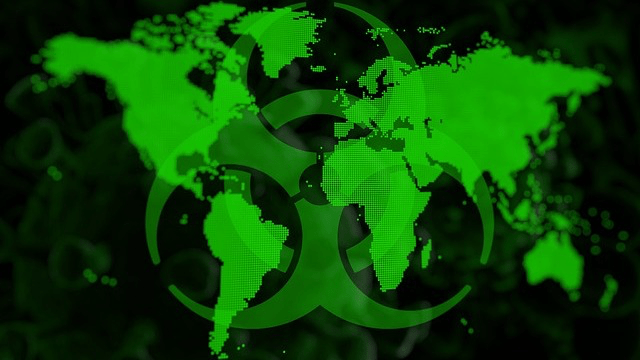
Other than the world falling apart, the outlook seemed good, Trump insisted. Perhaps the role of processes of globalization that are so clearly revealed by the trajectory of the epidemic stick in the throat or mind of Donald Trump. This is a deep cognitive problem, that would mean, that we cannot expect the President to process, as he continues to believe we can draw lines around the transmission of disease before the American people; but his mindset only echoes how we map by the misleading if not false buckets of jurisdictions and borders–although these are the closest we have to a health authorities, to be sure–and must rely on the datasets that nations release, with little global accords for transparency. The reverse has become true, as news media are frustrated in getting access to local numbers, and the danger grows that manny vital local news organizations simply won’t make it through the economic crisis that the health crisis has provoked.
How did it become so bad? The continued charisma of data led us to trust the best maps we can draw by the data that is available and on hand, even if we know it may not present a picture of viral transmission, carriers, or even deaths. We are left, as the best new source we might rely on, to plot the virulence of the spread of the coronavirus in ways that affirm its global proportions and scale, although we leave off the map those areas where no public health records are available–Mexico; much of Africa; Afghanistan and Turkmenistan–for which there is no data, and imagine South Africa as if it was a hotspot of the African continent, even if this is a distortion of datasets. But the designation of Europe as a central site of the virus’ spread, as China’s outbreak appeared contained, after drastic measures were taken, seemed to call for taking drastic, unilateral measures of our own, without even needing to consult other nations.
We were left to stare at the asymptotic curves of numbers of infections that had grown over three months in our interconnected globe the knows no real borders, moving from the exponential rise in cases of infection to the map and ask if any tie to a map made real sense, save, at this point, to grasp the very global nature of the viral outbreak, and the problem of whether we were only days or weeks before the uptick, facing an inevitably rising curve we as individuals might only hope to contain–as more people were infected outside China than within it by late February.

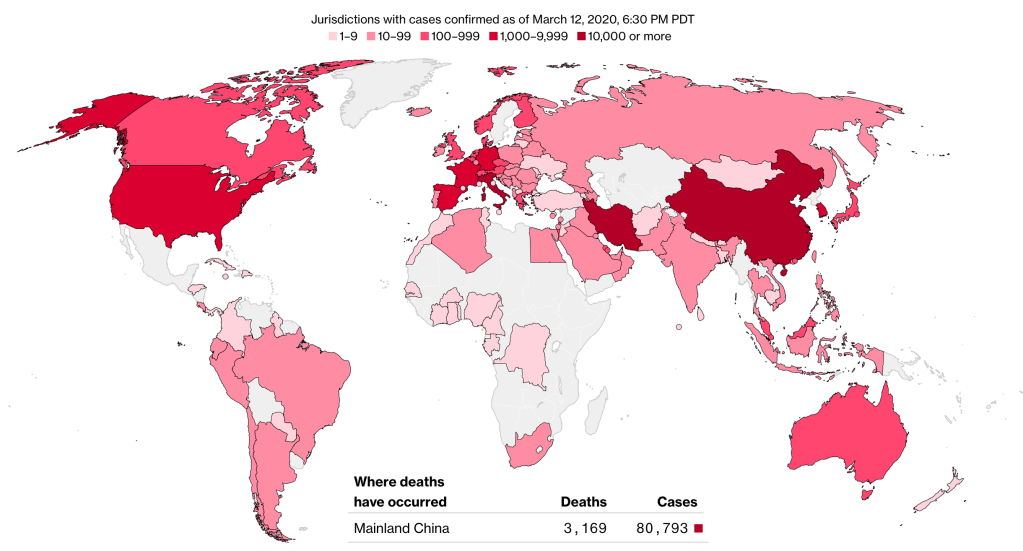
Coronavirus Pandemic/March 12, 2020 (Bloomberg)
The charisma of statistics already painted a grim picture that seemed as if it could not be understood outside the logic of globalization that Trump had long resisted and tilted against. He must not be able to stomach it. Luckily, marijuana legalization might get us through things, though the disconnect seemed so grave that the speech of what was a true state of the union was a disruption of proportions we could barely wrap our heads around, and were inevitably diminished by or faced to deny.

The truly pained President, seeming to struggle to get his mind around anything of global scope, but hoping he was able to stave off a massive selling off of stocks as equity futures declined without finding any vision of economic stimulus–as if the terms that President Obama had tried to champion as a means for securing a national recover might never be spoken from the resolute desk during his Presidency–led him only to assure the nation of paid sick leave for hourly workers, who must have only been wondering about their medical bills. While he may have been tempted to argue that luckily, global warming provided a sense of safety as the warming atmosphere would free the world from Coronavirus, he never went there, thankfully, but limited himself to paltry payroll tax exemptions, as if having the IRS take less out of paychecks was what the nation most of all wanted, as they saw the scope of their medical bills only rise–and not only for their elders–as we lacked any narrative or story map for the spread of infections on such terrifying asymptotic rise.
The poor practice of plotting raw data, without trying to craft anything like a story or narrative, even within the CDC, acting as if to defuse any epidemiological meaning in the below choropleth, converting CDC data into a visualization plot, without offering a handle to process total cases.

Yet the pace of the identification of confirmed cases over time seemed most crucial in many ways, as, even if we have no sense of incubation periods, choropleths provide poor senses of grasping the spread of the disease in ways that might help grasp the importance of social distancing, rather than shoveling sheer data at us that reflects the morass in which governments find themselves and project it onto the general public in quite disorienting ways.
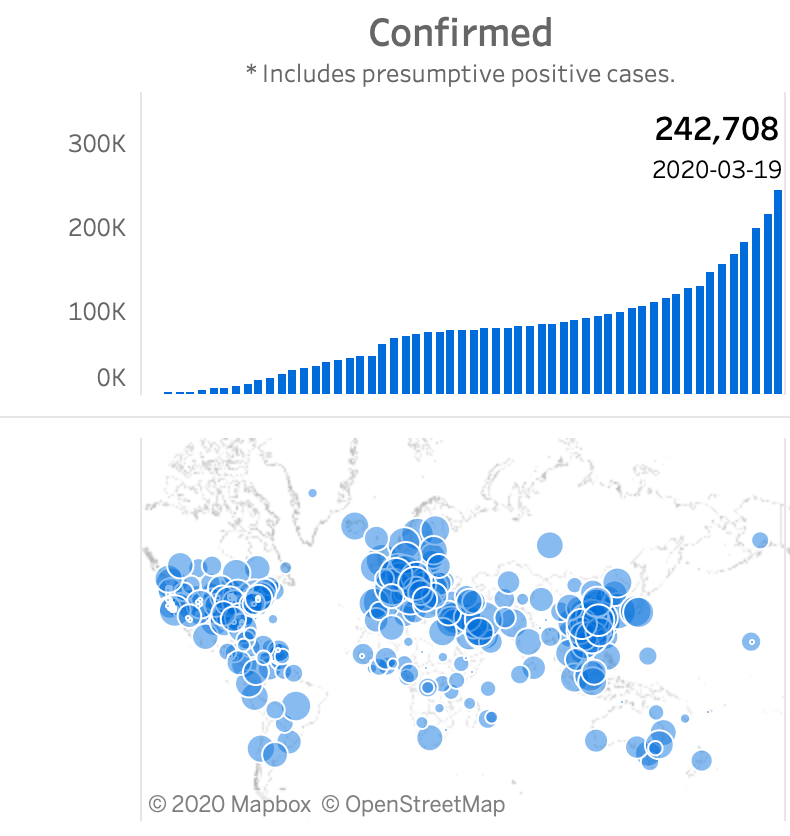
Trump tried, by the force of what seemed medication, to summon the needed gravitas to assuage worries. But the mental gears seems not to work before a pandemic that World Health Officials had declared global, of which his own health officials declared we had not yet seen the worst. All left to do was state in an unemotive–if not robotic–monotone displaying a lack of empathy or understanding. He seemed as if he was perhaps paralyzed by his own fears, that everything was under control and that we had the best doctors possible. We would get through this, he intoned, together, as we always did, turning to preaching a gospel of social solidarity curiously foreign to the Trump era; hardly believing the assertion he hoped would get him through the long night ahead, he spoke stonily as stock markets plummeted in Frankfurt as he said markets “are going to be just fine” as if repeating an incantation that seemed suddenly meaningless in a logic of magical thinking or forced optimism, while the virus spread more quickly outside China than within it.

And with American workers without paid sick leave or health coverage, the virus’ virulence would perhaps threaten the domestic economy more than China’s in our far denser cities, and the blow to our leisure economy, long nourished by our so-called “creative class.” But unemployment insurance was not to be touched, even as millions were quickly out of work, and the stimulus package produced in Congress got rid of the need for employers to retain workers and provide them with health care at large companies–Amazon; Walmart; Target; Walgreen–as millions were laid off without resources to care for themselves or receive medical care.
The prospect of no test kits, no cure, no therapeutic procedures, no basic tools to address the situation or sense of how to prevent communication of a virus that had already gotten out of the bag globally left it unclear what a President could do–especially one who trafficked exclusively in tired tropes of national boundaries. After all, after decades of repeating that things weren’t fine, and reciting a narrative that we were going to hell in a hand basket, the doom whose imminence he had been predicting to mass approval seems to have arrived. Indeed, the sense of an utter emergency that Trump had been decrying as imminent seemed to have arrived, only it wasn’t in national terms that it was best managed or even understood–and being ripped off wasn’t the issue; being inadequately protected was suddenly evident.
It might be the case that if one could stop time the night that he spoke, and sought to address the nation to calm the markets that incredibly seemed to be a more important audience than the health of the nation’s inhabitants, the spread was not that significant in a current visualization–if one discounted that these confirmed cases didn’t include any of those within whose body the virus was incubating, in whom symptoms of coughing, chills, and exhaustion had not yet presented themselves, even if they were already infected.
But if that was the situation in late January 2020, when the United States seemed far removed from the disproportionate numbers of confirmed sufferers of the coronavirus on a global scale, the notion that we could isolate and preserve ourselves from a virulent infection that had already arrived by closing borders was clearly preposterous, even if one had little expertise in epidemiology.

And even if the general numbers seemed distant, nothing lies overseas in a globe today that lacks edges, and whose networks were already delivering the virus not only to Italy, a chronically swollen boot in this cartogram by the master of the genre, Benjamin Hennig, based on WHO Coronavirus infections form COVID-19, but the global ballooning of infections was clearly impending, as all who have the heart to watch Hennig’s map animation of reported confirmed cases can attest.
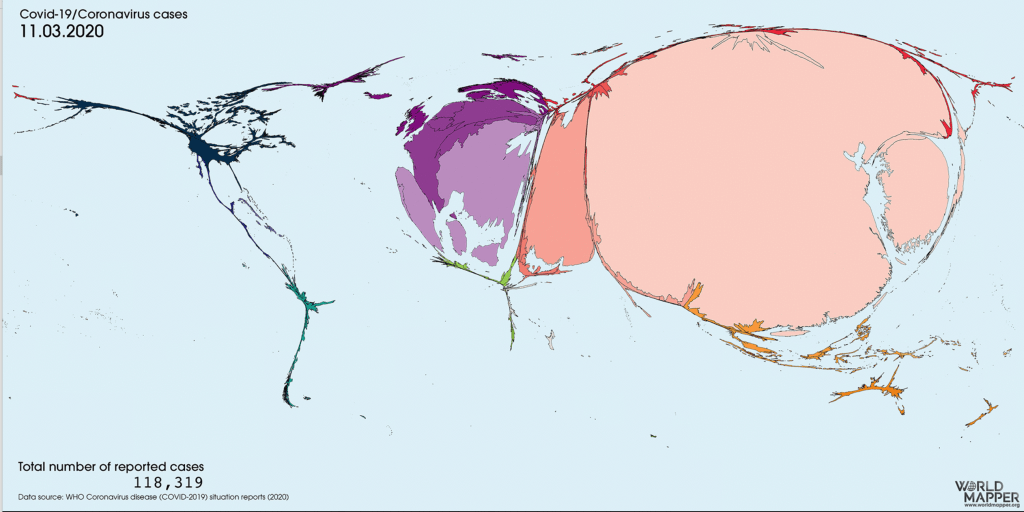
For all of Trump’s aim to sound decisive, he was posturing by announcing immediate suspension of flights from or to Europe. The sudden and totally unexpected announcement revealed utter inexperience at governing, made even more terrifying by the fact that he seemed to take pleasure in spurring a panicked booking of return flights in massive numbers, creating an onrush of returning passengers that airports had little preparation to process: the unclear nature of travel suspension policy declared to be immediate created panic among Americans who returned to face crowded lines for eight hours flooded cavernous airports from O’Hare to Dallas Ft. Worth, without plans or training to process their re-entry, a level of crowding that was the reverse of social distancing experts advised–without a clear protocol for containing the virus’ spread.

If Trump liked national emergencies as a constitutional workaround, the logic of us v. them wasn’t so compelling before Coronavirus, even if it was billed as a “foreign virus,” as if viruses also possessed nationalities. Would the disjuncture between the economy and his assertions prove problematic, or would concern with the absence of the arrival of something “better” than Obamacare that had not yet materialized? National emergencies recast the global pandemic in border-based terms, in keeping with an authoritarian tendencies familiar from the Trump Presidency. We wished we had the emergency on the scale of that he had declared as a workaround to accelerate construction of a border wall.
There was a sticky dissonance in looking at the stock market as a totem and god, whose health was equivalent to that of the nation–rather than the health of the nation’s residents. As stock futures and financial markets plunged globally, Trump rather preposterously suggested travel restrictions were the primary response that the virus required, with additional payroll tax cuts, he failed to address the lack of the availability of tests of infection by the Coronavirus that he had promised as forthcoming to anyone desiring them, just the previous Friday at his visit to the CDC, urging calm as stocks tried to absorb a global plunge he tried to forestall or block out by sticking to the teleprompter.
Traders overseas who watched Trump talk as the market was functioning saw the address create a sudden plunge in international markets. The scene created in Frankfurt was desparate, and the disappointment in the absence of any clear measures profound. Perhaps the only question was really whether in the face of such massive unpreparedness to coordinate a global effort, the markets would suck the global economy under, and if global markets would soon flatline, as Goldman Sachs had already warned as the virus spread to fifty countries in late February, based on examining the decline of economic productivity in China–with the virus having claimed 2,800 lives, but the virus had begun spreading more quickly outside China than within it.

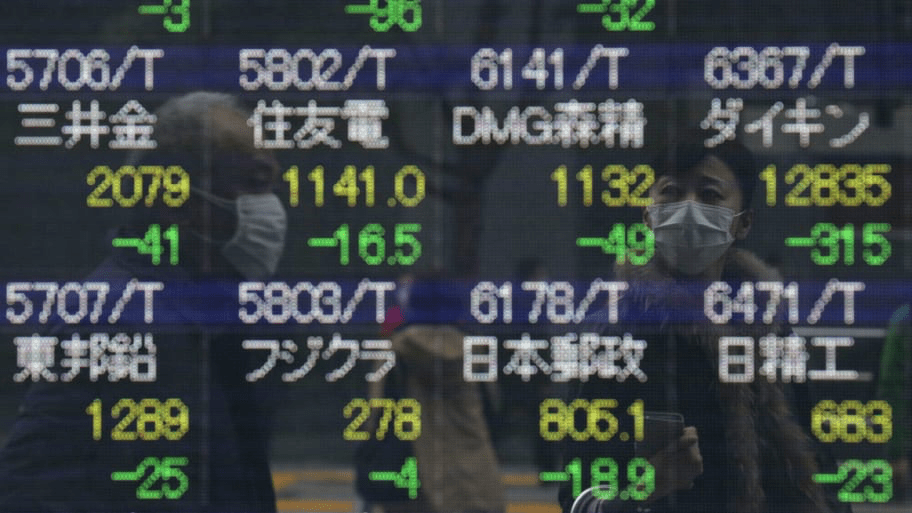

Even if we all knew, for the most part, that the limited statistics of infection and death in the United States on offer in the national maps of Coronavirus incidence were themselves undercounts as it was only based on positive tests administered by the CDC, whose downsizing both delayed and fail to accelerate enough testing to contain the virus. He tried to assure us that things were fine, as if to replace the image of these maps seared into our minds, by the gravitas of the monotone of his voice, perhaps; patience cracked at the very absurdity of his pronouncements as financial markets plunged globally as he preposterously suggested that travel restrictions were the primary response that the virus required, as well as more tax cuts, and injections of the sort he had never made before, in common memory, to keep calm–as if that was possible.
There was a problem in central casting before the inescapable fear of a great equalizer of something more close to biblical proportions than anything a nation-state could respond. But as images involuntarily returned of the Athenian plague, Black Death, or film scenarios of Bong Joon-ho that were not yet produced, the scope of the pandemic seems to push Trump off the stage. A suddenly miscast President tried to assure the markets, ham-fistedly, by projecting calm, so oddly unlike than emotive engagement and energy honed on Reality TV, as if to be jarringly dissonant, he seemed to seek to assume the adulthood for the nation he had long delayed to a late age, sitting behind a teleprompter. This was Nixon telling the country he was not a crook,–after all warnings of Nixonian comportment in Trump’s disdain of Congress aired in the Impeachment Hearings were ridiculed.
The pathos of the Trump moment seemed, however, far worse, and filled with tragedy. Bluster wasn’t appropriate here, and made no sense–gravitas was lacking, and he seemed tragically unable to sound reassuring as much as he spoke. And his jumping fingers seemed to know it, suggesting a seismograph that was underlying the empty injunctions of his words that had no bearing at all on the actuality of the unpreparedness of public hospitals, ventilators, or even isolation chambers, and the far off nature of hopes for any vaccine to arrive. The lack of availability of testing seemed incredible. The only possibilities of their provision by select businesses as if these constituted the only functioning parts of the nation suggested a return to local fiefdoms, as Amazon and the Gates Foundation stepped in in Seattle, given the utter lack of national coordination of a health policy, and Google later offered a functional health website to be pioneered in the Bay Area. But the costs of treatment for those with this coronavirus in the United States is estimated for someone with employer insurance—and are from any complications–as just under $10,000, and for those with complications could find that their bills more than double to $20,292. (Having a heart or lung disease, diabetes, or a suppressed immune system would create health care costs far more dangerous and prohibitive.)
And so the questions on everyone’s mind seemed pressing as they sought to protect themselves from the coronavirus’s spread.

We were all looking for feudal lords for protection, as the government wasn’t there. The disconnect between datasets and vectors of Coronavirus transmission, or between the growth of verifiably confirmed COVID-19 casts and geography, exposed the problems of a lack of leadership deeper than providing health care, if fundamental to doing so, as we were told the national health crisis had not yet reached its peak, as it would over time.

And the nation–and world–clearly knew it, even if there are no animated maps of the future. Trump’s laboriously read and oddly detached call for calm stood at odds with the disruption of global travel that he seemed to think himself entitled: the declaration was issued on prime time, to a global audience, looking for leadership, with assurances of the availability of tests for all who wanted them, when all knew that there were none on available or on offer at local hospitals, and had taken to hoard groceries, hand sanitizer, rubbing alcohol, and even toilet paper, as they got ready to hunker down for The Big One that seemed to have arrived. The lack of response–no discussion of the production of ventilators; no sense of publicly accessible stations of diagnosis; no sense of a timeline for expanding hospital facilities–was made more evident by the recourse to policing national frontiers as we all new Coronavirus had arrived and was undercounted.
Was this the voice of death, or the death of Trump, or the final end of a national health policy, from the top down? Only the distortions of the Mercator Projection allowed us to imagine areas of the world that were free from confirmed COVID-19 cases by late March, as the confirmed cases had in fact spread globally, and multiple popup ads reminded us to reconsider the immediate reaction of taking our IRA portfolios out of the stock market.
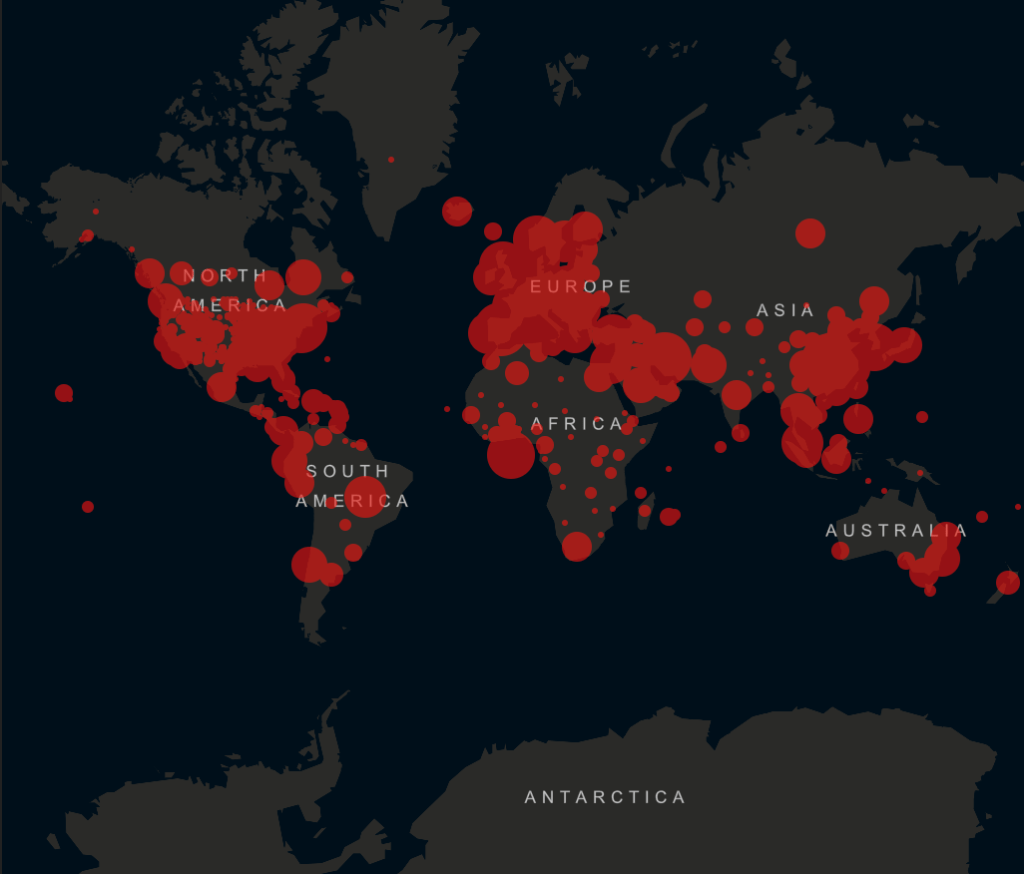


Such a good post!!! So insightful and spot on and horrifyingly true!
Painful to read but well-observed.